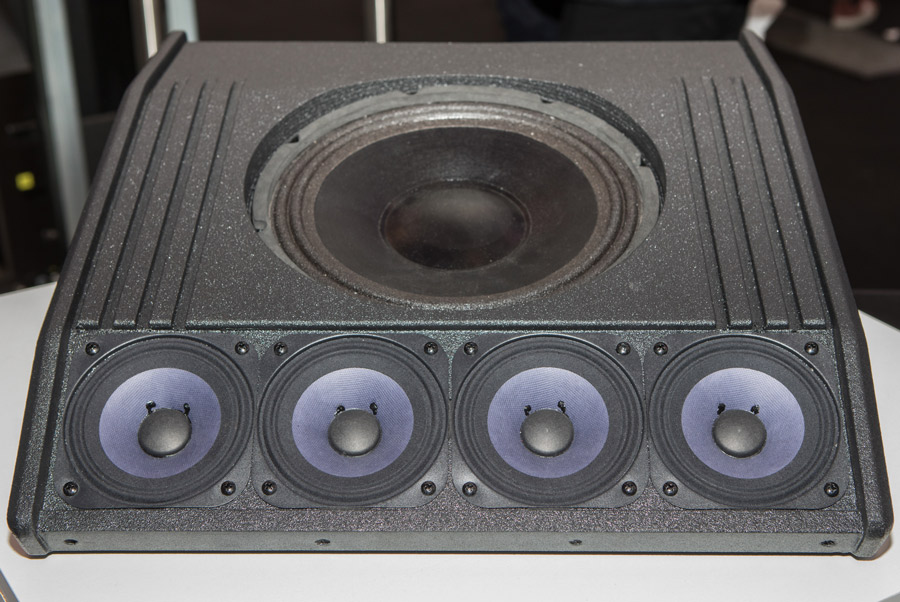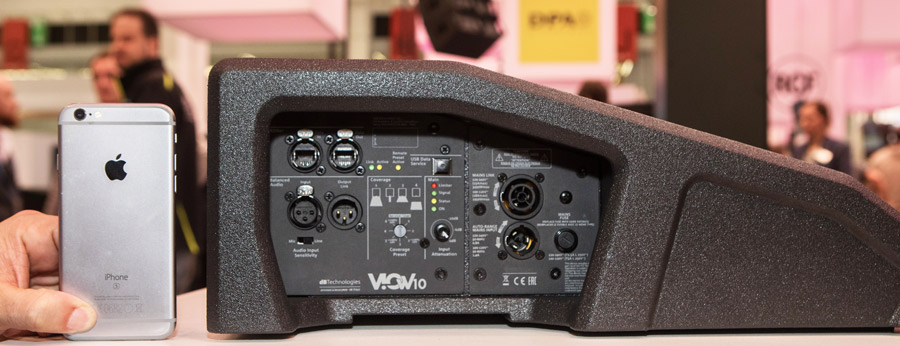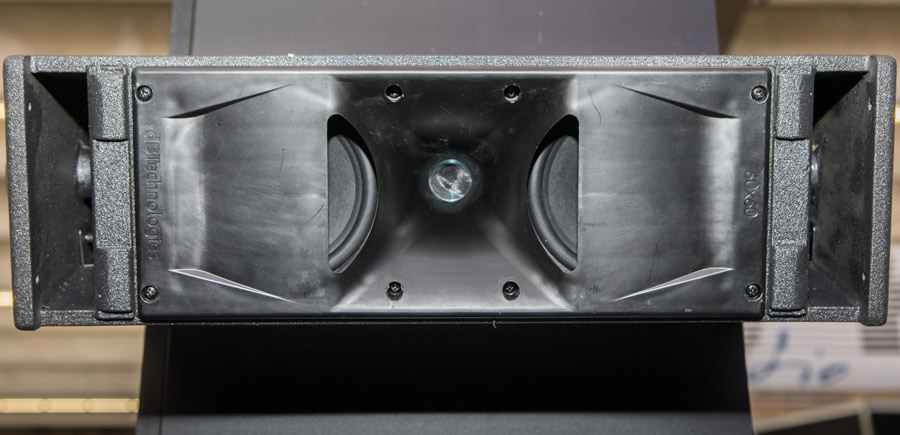
Present in full force with their big VIO L212 system in listening test, the italians guys from dbTechnologies also unveiled in Frankfurt two self-amplified newbies, practical and very well thought out:
– The small point source VIO X205 loudspeaker,
– And the ultra-flat VIO W10 wedge monitor.
To answer our questions we met on their Prolight+Sound stand in Frankfurt the Product Specialist Marco Cantalù and Enrico Gamberoni, dbTechnologies’ engineer, as fluent in acoustics as in marketing, and therefore analysis and transmission belt between the two departments.
VIO W10: flounders, better behave!
SoundLightUp : Where did the idea of an ultra flat wedge monitor come from?
Marco Cantalù (dbTechnologies Product Specialist) : We had discussions with the San Remo Festival teams, television channels and event service providers and they all told us they wanted to have “invisible” products. So we almost played around the idea and decided to start by employing compact transducers, but and still able to offer pressure and frequency response sufficient enough for professional use, without being “rock’n’roll”.

SLU : Other brands have used arrays of 4“ transducers since ages…
Enrico Gamberoni (Analyst & Market specialist) : No doubt, but not in ultra flat, amplified wedge monitors with variable directivity. (laughs)
Marco Cantalù : So, we have four wide range 4″ and a 10″ extremely flat speakers. These five transducers are connected to a 4-channel DiGiPro G3 amplifier with a total peak power of 400 W. Two outputs of this amp are in bridge mode for the 10″, and the other two channels are used on the two 4″ external ones for one channel, and the last one on the two internally positioned 4″.

This amplification set-up allows, via the internal DSP, to vary the directivity electronically by adjusting delay and filters. We have 4 positions. A normal, one where the lobe is enlarged, one where it is tightened and a last one where it is pushed back a few meters away which gives a wider use angle.
These four presets are inserted and selectable directly from the W10, but as it has a network port, it can also be controlled remotely. The connectors are IP65, which gives it the opportunity of outdoor use, and it could in the future be used as well hanging on a wall to further reduce its space on the ground, for example in a small jazz club.
SLU : The loading volume is compact, and I do not see any vent…
Enrico Gamberoni : There’s none. We went for closed load. This wedge monitor is a complex project, as we have different time alignments with the five transducers, and bringing in a vent with its turbulences would have complexified the whole lot and reduced the efficiency of the electronic waveguide.

SLU : Is it ready to take all the beatings a wedge monitor usually undergoes?
Enrico Gamberoni : Absolutely. It’s easy to carry around, less than 14 kg lightweight, and its grille is reinforced and step-proof. You can walk on it, the transducers are well protected. The max. SPL is 126 dB and the frequency response reaches 68 to 14 000 Hz at -6 dB. This opens the doors to TV sets, events, and all cases where the « low profile », in every term, is of the upmost importance, and more important than strictly power and dynamics. This is typically a niche product, ready to meet a lot of needs and peculiar requests.
VIO X205 : versatile in a (small) box
Second new product unveiled at Prolight+Sound, coming in two models, the X205-60 and the X205 -100. This is a small point source speaker designed around a 1.4” driver with constant directivity waveguide, with either 60°x60° or 100°x100° directivity, and in both versions flanked by two low frequency 5” woofers.

SLU : Active or passive ?
Enrico Gamberoni : Active, 2-way. The filter acts @ 1.5 kHz. The amplifier module is also home made. It is a DiGiPro G3, same generation as the one inside the W10 wedge monitor, it is very flexible indeeed. The big advantage of this little loudspeaker is that it can reach 85 Hz at -3 dB with its two 5“, which means for a conference I don’t need anything else. Via RDNet, I can program in the on-board DSP a delay up to 20 meters, so its use as lipfill is very simple indeed.

The max. SPL is 126 dB. The two openings bring a lot of versatility. At 60° the throw is enhanced, at 100° it is more pleasant in close reach. It can be hung in any way you need, and has a bottom hole for pole mounting. Despite its size, the cabinet is made of wood and its total weight is 7 kg only. The number of applications is almost infinite, stage, theatre, event, worship halls…

SLU : Enrico, your power and SPL data seem very reasonable…
Enrico Gamberoni : They are indeed. First of all, we made the choice to work with the same measurement norms on all the VIO range, dans the GLL files are downloadable directly on our Website. Regarding the max. SPL, we integrate pink noise during 5 minutes with a peak factor of 6 dB.
We do this in our anechoic chamber, where we have a robotized arm, allowing us to find the best measurement point in the polar field, then we position the microphone at 3.25 meters distance, and then recalculate the value at one meter. Regarding the power delivered by our modules, it goes the same way. We don’t artificially overestimate our data, since the watt by itself doesn’t really mean anything.

Knowing what the unit can handle is no big deal, opposite to what SPL it can deliver. (laughs) It is the same with the settings of our protections.
We don’t fool around with the SPL war, limiting in multi-bands the low frequencies before the other bands, just to display some extra dBs, at the expense of the general rendering quality. When we start going into limitation, we do it over the whole spectrum to preserve the sonic balance.
More information on dbTechnologies Website.







